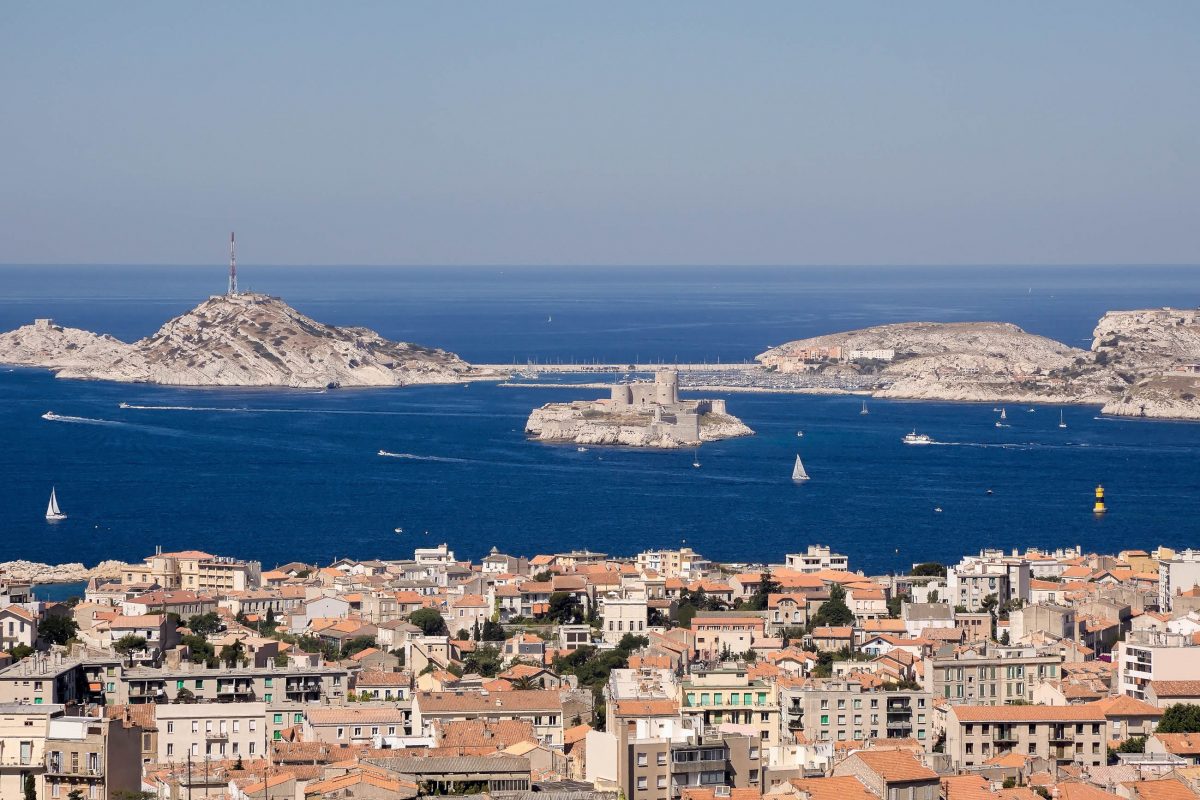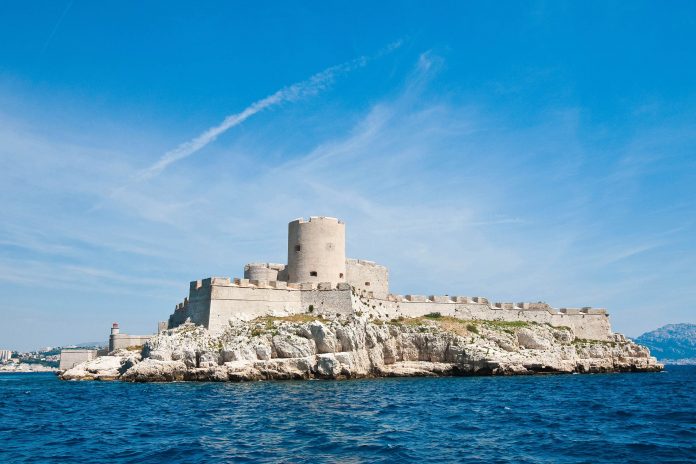Das ehemalige Gefängnis „Château d’If“ auf einer der Frioul-Inseln vor der Küste von Marseille ist durch den Roman „Der Graf von Monte Cristo“ weltweit bekannt und somit beliebtes Ziel für Touristen.
Von den Frioul-Inseln vor der Küste von Marseille ist If wohl die berühmteste. Diesen Umstand hat der unscheinbare Felsbrocken im Mittelmeer seiner stolzen Festung zu verdanken. Das ehemalige Staatsgefängnis „Château d’If“ ist spätestens seit „Der Graf von Monte-Cristo“ weltweit bekannt und lockt jedes Jahr zahlreiche Touristen auf den Plan. Wir haben es auf unsere Liste der Top 10 Sehenswürdigkeiten von Marseille aufgenommen.
Das gesamte Archipel formt mit seinen kalkweißen Klippen im glitzernden Blau des Mittelmeeres ein perfektes Fotomotiv. Den besten Blick auf die Frioul-Inseln bieten der Alte Hafen oder auch die Basilika Notre Dame de la Garde von ihrem Hügel über der Stadt.
Inhaltsverzeichnis
BILDER: Château d’If vor Marseille
Fotogalerie: Château d’If in Marseille
Errichtung von Château d’If

Errichtet wurde die Festung auf der Insel If von 1524 bis 1531 unter König Franz I., da der Hafen von Marseille davor noch über keinerlei Schutz verfügte. Erst 1481 wurde Marseille unter die Herrschaft von Paris gestellt und der Bau von Château d’If führte als Bevormundung in Bezug auf die örtliche Verteidigung zu reichlich Unmut beim Volk.
Soviel die Bürger auch schimpften, die Festung auf der rund 3 Hektar großen Felseninsel erfüllte ihren Zweck. Aufgrund ihrer abschreckenden Wirkung wurde sie nur einmal fünf Jahre nach ihrer Fertigstellung vom spanischen König erfolglos angegriffen und anschließend lange von Fischern, Piraten und Schmugglern als Anlaufstelle genutzt.
Zum französischen Staatsgefängnis wurde Château d’If ab 1580. Aufgrund seiner mächtigen Mauern und der exponierten Lage schien ein Ausbruch unmöglich.
Berüchtigtes Gefängnis und Romanvorlage

Mit seinem Roman, „Der Graf von Monte-Cristo“ hat Alexandre Dumas der jahrhundertealten Festungsinsel vor Marseille zu weltweiter Bekanntheit verholfen. Der Autor hatte das Bollwerk als jenen Ort auserkoren, in dem seine Hauptfigur, Edmond Dantés, ungerechtfertigt 13 Jahre verbringen musste, bevor er fliehen und an seinen Verschwörern grausame Rache üben konnte. Seine Flucht über das Meer inspirierte übrigens den jährlichen Schwimm-Wettbewerb „Monte-Cristo-Challenge“.
Einige tausend Unglückliche, vor allem Demonstranten, Protestanten und politische Gegner, wurden im Château d’If inhaftiert, darunter der Großteil ohne richterliches Urteil, sondern aufgrund eines königlichen Befehls. Ein gewisser Monsieur de Niozelles soll 6 Jahre eingesperrt gewesen sein, weil er versäumt hatte, in Gegenwart des Königs Ludwig XIV. seinen Hut zu ziehen.
Zu den berühmtesten Insassen des Château d’If gehört Mirabeau, ein Held der Französischen Revolution, den 1774 sein eigener Vater ins Gefängnis werfen ließ. Immerhin hatte er ganz im Gegensatz zu anderen Häftlingen, die in nackten, fensterlosen Zellen ausharren mussten, ein eigenes geräumiges Zimmer mit Ausblick und Kamin. Angeblich verführte er sogar die Köchin.
Besuch von Château d’If

Das berühmt-berüchtigte Gefängnis von If wurde 1890 aufgelassen und für Besucher zugänglich gemacht. Heute ist die 28m lange, quadratische Festung eine Touristen-Attraktion, die seit 1926 auch unter Denkmalschutz steht, und nicht nur für begeisterte Romanleser von Interesse.
In nur wenigen Minuten ist das Château d’If vom Alten Hafen von Marseille mit dem Boot erreicht. Die Kalksteininsel kann kostenlos besichtigt werden, wer die dreistöckige Festung auch betreten möchte, muss Eintritt zahlen.
Die Tour durch das Innere führt durch die ehemaligen Gefängniszellen, in denen ein Souvenir-Shop und Ausstellungen über die Geschichte von Château d’If, den Roman von Dumas und das erste Nashorn Europas eingerichtet wurden.
Tipp: Achtung! Vor allem zwischen März und April verhalten sich die Möwen auf der Insel If sehr aggressiv, da sie ihre Nester verteidigen.
Das erste Nashorn Europas
Unter Franz I. geschah es auch, dass das erste Nashorn, das Europa je zu Gesicht bekam, auf Château d’If Station machte. Der König von Portugal erhielt es damals von einem indischen König als Geschenk, der es jedoch an den Papst in Rom weiter schenken wollte. Von Lissabon dorthin war im Jahr 1516 die Insel If als Zwischenstopp eingeplant. Sowohl der König, als auch das französische Volk wollten das fremdartige Geschöpf unbedingt zu Gesicht bekommen. Auf der Weiterreise nach Rom erlitt der Frachter allerdings Schiffbruch und das Nashorn kam nur noch in ausgestopfter Form bei Papst Leo X. an.
Weitere Sehenswürdigkeiten der Frioul-Inseln

Neben If gehören noch die Kalksteininseln Pomèques, Ratonneau und Tiboulen zu den Frioul-Inseln, auf denen sich eine teils ganz eigene Flora und Fauna entwickelt hat. Vom höchsten der drei Rundtürme, dem 22m hohen „Saint Christophe“, bietet sich ein traumhafter Blick auf die übrigen Frioul-Inseln und die Küste von Marseille.
Zusätzlich zur Festung auf If gibt es auf den Frioul-Inseln noch die Meerbarsch-Zuchtstation auf Pomègues, die weltweit erste Bio-Zuchtstation, die ehemalige Quarantäne-Station Hôpital Caroline auf Ratonneau und einen Jachthafen bei Port Frioul zu besichtigen. Zwischen dem Hafen und dem Spital verkehrt auf Ratonneau ein kleiner Touristen-Zug, hier gibt es auch einige Lokale für den kleinen Hunger zwischendurch.




